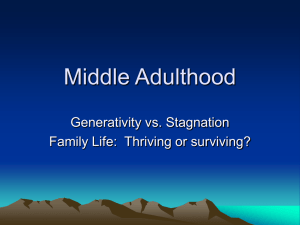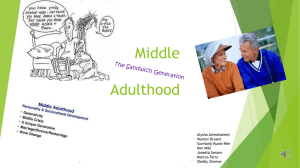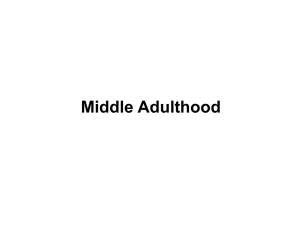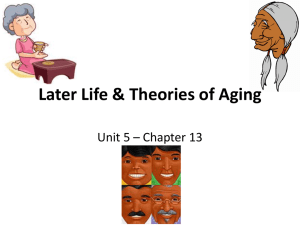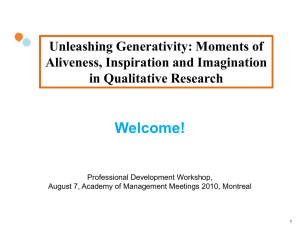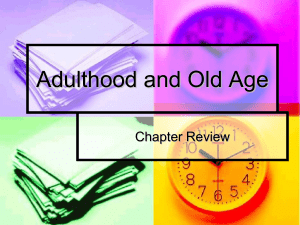Adult Life & Theories of Aging
advertisement
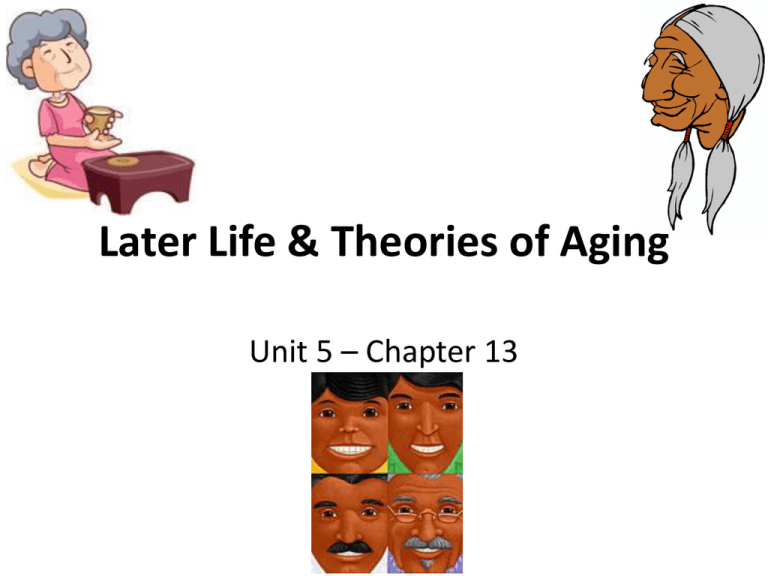
Later Life & Theories of Aging Unit 5 – Chapter 13 Middle Adulthood • Middle age is defined as the stage of life from 45 to 64 years of age • As Canadians delay the major transitions of life, the traditional image of middle age as the time when children “are launched from the nest” and parents settle down to wait for grandchildren no longer fits the lifestyle of middle-aged Canadians The Sandwich Generation • An increasing number of adults are providing some care to aging parents • In addition, emerging adults tend to remain at home longer • As a result, parents who delayed childbearing until their late 20s or early 30s may have adult children at home until they are almost 60 • Those who have responsibilities for children and aging parents are referred to as the sandwich generation The Sandwich Generation • Women in midlife shoulder most of the burden of caring for older parents who become physically dependent on others • Women are more likely to work part-time to accommodate their caregiving responsibilities • Caregiving is defined as providing care to a family member who is suffering from a physical or mental disability, is chronically ill, or frail The Sandwich Generation • In some cases, care becomes a fulltime responsibility • Social polices in Canada assume that the family will take care of its dependent members in the same way that they take care of children • Those being cared for include older parents, ill or frail spouses and disabled children The Sandwich Generation • Most Canadians report that they would prefer not to be cared for by their families if physical care becomes necessary, but sometimes their financial situation leaves no other option • Because of the improved life expectancy of older Canadians, their physical dependency often coincides with the retirement of their caregivers The Sandwich Generation • In some cases, individuals take early retirement to be available to care for a spouse or parent • Although caregiving can be both socially and financially beneficial for dependents; loss of employment , increase in parttime work, or early retirement can have long-term effects on the middle-aged caregiver’s income and pension Becoming Grandparents • The role of grandparent developed in the 20th century, when couples had children while they were young, when their children married younger and had children even earlier than their parents did, and when people lived longer • In the 1980s, many Canadians became grandparents in their 40s and 50s, so grandparents were younger, probably working and living active, independent lives Becoming Grandparents • Only 3% of Canadians under the age of 50 are grandparents now, by age 60 half of these individuals have grandchildren and by 70 over 80% of older adults are grandparents • On average, grandparents have 4.7 grandchildren • Although 1 in 5 children have no contact with a grandparent, 40% see them at least once a month • Grandparents serve an important role in the socialization of grandchildren Becoming Grandparents • Grandparents provide a valuable role as family historian, linking children with their family’s ethnic and cultural past • Grandparents serve as role models for older adulthood and may counteract the stereotypical images of later life • They may act as mentors who are experienced in life transitions within the family Becoming Grandparents • Grandparents might receive more affection and recognition from their grandchildren than they did from their children because they are free of the obligation to be a disciplinarian • If grandparents and grandchildren form a cross-generational alliance when there is conflict between parent and child, they can interfere with the parent’s ability to raise their child independently The Stability Template Model • Assumes that individuals do not change once they achieve adulthood • Based on the belief that the basic personality is formed in childhood • This model explains that if an individual’s identity is stable over time, they will respond to events and stresses in life in a consistent manner • There will be variations in behaviour from person to person, but an individual’s behaviour will be predictable The Orderly Change Model • Explains that an individual’s identity is formed earlier in life but changes through interaction with the environment in the present • Daniel Levinson suggests that in midlife, individuals examine their Dream, the life structure they have been building in early adulthood, and define a new life structure for themselves in later life based on changing circumstances • Suggests that identity changes according to the options available in society The Theory of Random Change • Explains that fate, or non-normative events, causes change in identity because of how individuals adapt to their new roles • Patterns of behaviour exist because cohorts are exposed to the same events • Although the behaviour of individuals within generations might conform to a pattern, it is not possible to predict the behaviour of future generations Generativity • Meaning productivity • The range of ways people are able to reach out to leave their mark on future generations • By investing in the future and caring for others, individuals can develop the virtue of care • However, by becoming self-indulgent, focusing only on their own lives, individuals do not develop, a state that Erikson called stagnation Generativity • Individuals may have a need to nurture others, but society expects adults to take responsibility for themselves, care for their children and pass on the culture to their offspring • Therefore, adults in their 30s and 40s who are not ready for steady employment and a family are considered to be “out of time” with the social clock Generativity • People who do not meet the time lines of the society in which they live might be judged as “immature” and be encouraged to “settle down” • Generativity is a universal task of adulthood, but the form and the timing are defined by the society Generativity • However, for some individuals, generativity is not attainable • They may feel that they cannot generate good products and outcomes, that they are unable to leave a positive mark on their world • Their struggle to tend to and maintain themselves may be so taxing that they cannot find the resources to care for those who will eventually survive them Forms of Generativity • Generativity is the motivation for the rest of adult life • Psychologist John Kotre states that because of the limits of fertility, especially for women, generativity must be defined as something more than reproduction and parenthood Forms of Generativity 1) Biological generativity or parenthood 2) Parental generativity or the raising of children 3) Technical generativity or the passing on of knowledge 4) Cultural generativity or the sharing of culture and tradition Biological Generativity • Parenthood is occurring later in life for most Canadians • As a result of the impact of contraception, parenthood has become a choice • Individuals saw less need for children when improved health enabled them to live longer and healthier lives in which they could accomplish their goals • Therefore, there is currently less biological generativity Parental Generativity • Attained through interaction with children, as active participants in parenting • In the past, women bore most of the responsibility for childcare and parenting, so parental generativity was assumed to be the motivation for a woman’s life in adulthood • Now, men have gained greater opportunities for parental generativity as they share an active parenting role with their working wives Parental Generativity • Increased life expectancy is changing the nature of parental generativity • A longer life allows individuals to have longer connections with past and future generations within the family • Grandparenting provides additional parental generativity roles • Those who did not have children achieve parental generativity by taking on the role of “guardian” and caring for others’ children as teachers or childcare providers Technical Generativity • Another way of providing for the future and leaving one’s mark on the world that extend beyond family • Technical Generativity means teaching knowledge and skills to the next generation so that they can develop competence • Parents or aunts and uncles teaching children, teachers instructing students and older men and women mentoring younger adults are some examples of the ways technical generativity is expressed Cultural Generativity • Means creating and sharing ideas and artifacts that will contribute to the cultural experience of society • Whether by producing beneficial products or services at work or by expressing creativity by sewing painting, singing, writing or dancing, individuals can achieve cultural generativity • Like Technical Generativity, Cultural Generativity can be achieved by developing and nurturing ideas Bereavement • Marriage is much more likely to be dissolved by death in old age, not by divorce • The death of a spouse is the most stressful and disruptive event in life • Because women have traditionally married men who are several years older and because the life expectancy of men is shorter by several years, women are more likely than men to be widowed Bereavement • Women will probably spend their final years alone, while men are likely to die with a spouse and family around them • In 2001, 42% of older women were widowed compared to 11.2% of men • Men have more difficulty adjusting to the death of their spouse than women do • Men tend to have a greater dependence on their wives for meeting their needs Bereavement • Traditionally, men have fewer close friends and depend on their partners for companionship • Men have performed fewer household activities in the past, so the loss of their wife has a greater impact on their lifestyle • The older a woman is when her husband dies, the more likely she is to live alone Bereavement • Three-quarters of Canada’s older widows are living on their own, but few of them report being lonely • Women are less likely to remarry than men • Women compared to men, have more actively maintained family ties and have closer relationships with their children and friends The Stages of Death • Dr. Elisabeth Kubler-Ross made it her life’s work to study the process of dying to learn how to support those who are dying • She identified 5 stages of death, which are experienced in order, if there is time 1) Denial of the diagnosis and attempting to find a solution or another explanation 2) Anger at the fact of death, which might be directed at anyone, including self, family or health-care staff The Stages of Death 3) Bargaining, with promises to alter who they are and what they do, to change the diagnosis 4) Depression, arising from the certainty of death and the resignation that there is no hope 5) Acceptance, indicating that the individual has come to terms with his or her fate and is ready to prepare for the end of life Grieving • The grieving process occurs in 3 distinct but overlapping phases over a period of several years 1) In the shock phase, bereaved individuals experience periods of numbness and crying. Daily activities will be disrupted and are completed with little thought or pleasure. At this time, others might wish to increase their closeness, but the bereaved person might prefer time alone. Grieving 2) In the disorganization phase, there is a need to talk about the deceased person and vent feelings of sadness, anger, anxiety and guilt. A person might be less able to function in day-to-day life because of the necessity to make lifestyle changes. Unfortunately, other people are less available to talk after the brief period of mourning. Grieving 3) In the reorganization phase, new routines have been established for day-to-day life and there is less evident grief. The bereaved person has a new relationship with the deceased as someone they remember rather than someone with whom they share their life.
